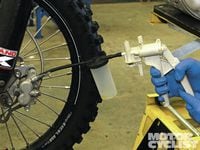There are several excellent reasons to bleed your motorcycle’s hydraulic brake and clutch lines. For perform-ance-minded riders, there are the always popular braided stainless-steel or Teflon hoses to install. You might also be in the midst of replacing some brake or clutch component. Others, concerned with reliability in addition to performance, could be flushing out old fluid and replacing it with new.
Brake fluid absorbs water from the air, and after a period of time loses important properties that new, clean fluid possesses. A casual rider should replace the brake fluid at the beginning of each riding season. Sporting riders should replace it more often, and that is doubly true of most high-temperature or “racing” fluids. The fluid should be replaced any time you note a change in color to dark brown or black. Always use brand-new fluid from a sealed container and stick with the type specified on the master cylinder: DOT 3, 4, 5, etc. Note that some clutch systems specify mineral oil like that used in mountain-bike brakes, particularly European dirtbikes
Dealing with a hydraulic system can lead to a frustrating man-cave session. It sometimes seems that you need three hands! Fortunately, there are a variety of products to help bleed a brake or clutch system. If you have to replace a line or a caliper and the system is dry, getting the system to operate without a brake-bleeding tool is extremely time-consuming. Today these tools are as close as the corner auto-parts store, and production volume has brought prices down. Some of these tools are hand-operated while others require a source of compressed air. Mityvac is the most common brand, but there are others. Most of these devices create a vacuum to pull fluid through the system. The job then becomes quick, clean, effective—and a whole lot less frustrating.

/cloudfront-us-east-1.images.arcpublishing.com/octane/KKHQHRR3FJGX7H2IPU6RALMWG4.jpg)

/cloudfront-us-east-1.images.arcpublishing.com/octane/5IOFS5JAE5FOXMNA23ZRAVVYUU.jpg)
/cloudfront-us-east-1.images.arcpublishing.com/octane/CGXQ3O2VVJF7PGTYR3QICTLDLM.jpg)

/cloudfront-us-east-1.images.arcpublishing.com/octane/OQVCJOABCFC5NBEF2KIGRCV3XA.jpg)
/cloudfront-us-east-1.images.arcpublishing.com/octane/OPVQ7R4EFNCLRDPSQT4FBZCS2A.jpg)
/cloudfront-us-east-1.images.arcpublishing.com/octane/YBPFZBTAS5FJJBKOWC57QGEFDM.jpg)
/cloudfront-us-east-1.images.arcpublishing.com/octane/W5DVCJVUQVHZTN2DNYLI2UYW5U.jpg)
/cloudfront-us-east-1.images.arcpublishing.com/octane/C3VIRIAYNZCTJAZNRLREDS3JCM.jpg)
/cloudfront-us-east-1.images.arcpublishing.com/octane/XXWKUKITWRAF3HCJAWGJ25V7BA.jpg)
/cloudfront-us-east-1.images.arcpublishing.com/octane/MALB2TULBRCQJJ3P3UXMU2N7QE.jpg)
/cloudfront-us-east-1.images.arcpublishing.com/octane/B6KMLYR3T5GMNA7F7URZVLO72I.jpg)
/cloudfront-us-east-1.images.arcpublishing.com/octane/RIBH2PB5DBFEZFEYXDOD5Z6ECA.JPG)
/cloudfront-us-east-1.images.arcpublishing.com/octane/FY7HQZFIM5CYVAKOLBQ5F7BWZU.JPG)
/cloudfront-us-east-1.images.arcpublishing.com/octane/YGET42VCYRCEBOLKHTHFQGH72A.jpg)
/cloudfront-us-east-1.images.arcpublishing.com/octane/YLPY3KQYRVD2JG3RJMEQB4574A.jpg)
/cloudfront-us-east-1.images.arcpublishing.com/octane/RDF24VM7WVCOBPIR3V3R4KS63U.jpg)
/cloudfront-us-east-1.images.arcpublishing.com/octane/WQ2LIEL7RFBXFATR5LA6GOSRXE.jpg)
/cloudfront-us-east-1.images.arcpublishing.com/octane/W2F2QHY4VVFM7AJMV7N5SHSBPY.jpg)
/cloudfront-us-east-1.images.arcpublishing.com/octane/AFW7GSF47NEAPMYGVJ5RMMBDNE.jpg)
/cloudfront-us-east-1.images.arcpublishing.com/octane/GJHLAGRYXBH6BGCISATHTBLU24.jpg)
/cloudfront-us-east-1.images.arcpublishing.com/octane/HVZE5SURNNAYDLJVQ2BTWECIVI.jpg)
/cloudfront-us-east-1.images.arcpublishing.com/octane/NP5FHV6NRBGX5LQRUK3CA6A4BM.jpg)